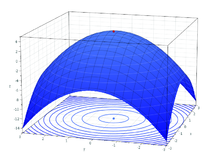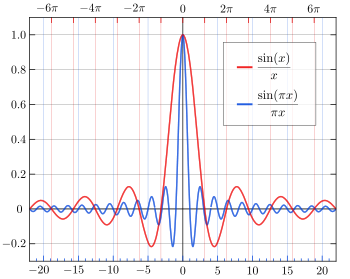Maximum and minimum

Inmathematical analysis,themaximumandminimum[a]of afunctionare, respectively, the largest and smallest value taken by the function. Known generically asextremum,[b]they may be defined either within a givenrange(thelocalorrelativeextrema) or on the entiredomain(theglobalorabsoluteextrema) of a function.[1][2][3]Pierre de Fermatwas one of the first mathematicians to propose a general technique,adequality,for finding the maxima and minima of functions.
As defined inset theory,the maximum and minimum of asetare thegreatest and least elementsin the set, respectively. Unboundedinfinite sets,such as the set ofreal numbers,have no minimum or maximum.
Instatistics,the corresponding concept is thesample maximum and minimum.
Definition
[edit]A real-valuedfunctionfdefined on adomainXhas aglobal(orabsolute)maximum pointatx∗,iff(x∗) ≥f(x)for allxinX.Similarly, the function has aglobal(orabsolute)minimum pointatx∗,iff(x∗) ≤f(x)for allxinX.The value of the function at a maximum point is called themaximum valueof the function, denoted,and the value of the function at a minimum point is called theminimum valueof the function. Symbolically, this can be written as follows:
- is a global maximum point of functionif
The definition of global minimum point also proceeds similarly.
If the domainXis ametric space,thenfis said to have alocal(orrelative)maximum pointat the pointx∗,if there exists someε> 0 such thatf(x∗) ≥f(x)for allxinXwithin distanceεofx∗.Similarly, the function has alocal minimum pointatx∗,iff(x∗) ≤f(x) for allxinXwithin distanceεofx∗.A similar definition can be used whenXis atopological space,since the definition just given can be rephrased in terms of neighbourhoods. Mathematically, the given definition is written as follows:
- Letbe a metric space and function.Thenis a local maximum point of functionifsuch that
The definition of local minimum point can also proceed similarly.
In both the global and local cases, the concept of astrict extremumcan be defined. For example,x∗is astrict global maximum pointif for allxinXwithx≠x∗,we havef(x∗) >f(x),andx∗is astrict local maximum pointif there exists someε> 0such that, for allxinXwithin distanceεofx∗withx≠x∗,we havef(x∗) >f(x).Note that a point is a strict global maximum point if and only if it is the unique global maximum point, and similarly for minimum points.
Acontinuousreal-valued function with acompactdomain always has a maximum point and a minimum point. An important example is a function whose domain is a closed and boundedintervalofreal numbers(see the graph above).
Search
[edit]Finding global maxima and minima is the goal ofmathematical optimization.If a function is continuous on a closed interval, then by theextreme value theorem,global maxima and minima exist. Furthermore, a global maximum (or minimum) either must be a local maximum (or minimum) in the interior of the domain, or must lie on the boundary of the domain. So a method of finding a global maximum (or minimum) is to look at all the local maxima (or minima) in the interior, and also look at the maxima (or minima) of the points on the boundary, and take the largest (or smallest) one.
Fordifferentiable functions,Fermat's theoremstates that local extrema in the interior of a domain must occur atcritical points(or points where the derivative equals zero).[4]However, not all critical points are extrema. One can often distinguish whether a critical point is a local maximum, a local minimum, or neither by using thefirst derivative test,second derivative test,orhigher-order derivative test,given sufficient differentiability.[5]
For any function that is definedpiecewise,one finds a maximum (or minimum) by finding the maximum (or minimum) of each piece separately, and then seeing which one is largest (or smallest).
Examples
[edit]
| Function | Maxima and minima |
|---|---|
| x2 | Unique global minimum atx= 0. |
| x3 | No global minima or maxima. Although the first derivative (3x2) is 0 atx= 0, this is aninflection point.(2nd derivative is 0 at that point.) |
| Unique global maximum atx=e.(See figure at right) | |
| x−x | Unique global maximum over the positive real numbers atx= 1/e. |
| x3/3 −x | First derivativex2− 1 andsecond derivative2x.Setting the first derivative to 0 and solving forxgivesstationary pointsat −1 and +1. From the sign of the second derivative, we can see that −1 is a local maximum and +1 is a local minimum. This function has no global maximum or minimum. |
| |x| | Global minimum atx= 0 that cannot be found by taking derivatives, because the derivative does not exist atx= 0. |
| cos(x) | Infinitely many global maxima at 0, ±2π,±4π,..., and infinitely many global minima at ±π,±3π,±5π,.... |
| 2 cos(x) −x | Infinitely many local maxima and minima, but no global maximum or minimum. |
| cos(3πx)/xwith0.1 ≤x≤ 1.1 | Global maximum atx= 0.1 (a boundary), a global minimum nearx= 0.3, a local maximum nearx= 0.6, and a local minimum nearx= 1.0. (See figure at top of page.) |
| x3+ 3x2− 2x+ 1 defined over the closed interval (segment) [−4,2] | Local maximum atx= −1−√15/3, local minimum atx= −1+√15/3, global maximum atx= 2 and global minimum atx= −4. |
For a practical example,[6]assume a situation where someone hasfeet of fencing and is trying to maximize the square footage of a rectangular enclosure, whereis the length,is the width, andis the area:
The derivative with respect tois:
Setting this equal to
reveals thatis our onlycritical point. Now retrieve theendpointsby determining the interval to whichis restricted. Since width is positive, then,and since,that implies that. Plug in critical point,as well as endpointsand,into,and the results areandrespectively.
Therefore, the greatest area attainable with a rectangle offeet of fencing is.[6]
Functions of more than one variable
[edit]


For functions of more than one variable, similar conditions apply. For example, in the (enlargeable) figure on the right, the necessary conditions for alocalmaximum are similar to those of a function with only one variable. The firstpartial derivativesas toz(the variable to be maximized) are zero at the maximum (the glowing dot on top in the figure). The second partial derivatives are negative. These are only necessary, not sufficient, conditions for a local maximum, because of the possibility of asaddle point.For use of these conditions to solve for a maximum, the functionzmust also bedifferentiablethroughout. Thesecond partial derivative testcan help classify the point as a relative maximum or relative minimum. In contrast, there are substantial differences between functions of one variable and functions of more than one variable in the identification of global extrema. For example, if a bounded differentiable functionfdefined on a closed interval in the real line has a single critical point, which is a local minimum, then it is also a global minimum (use theintermediate value theoremandRolle's theoremto prove this bycontradiction). In two and more dimensions, this argument fails. This is illustrated by the function
whose only critical point is at (0,0), which is a local minimum withf(0,0) = 0. However, it cannot be a global one, becausef(2,3) = −5.
Maxima or minima of a functional
[edit]If the domain of a function for which an extremum is to be found consists itself of functions (i.e. if an extremum is to be found of afunctional), then the extremum is found using thecalculus of variations.
In relation to sets
[edit]Maxima and minima can also be defined for sets. In general, if anordered setShas agreatest elementm,thenmis amaximal elementof the set, also denoted as.Furthermore, ifSis a subset of an ordered setTandmis the greatest element ofSwith (respect to order induced byT), thenmis aleast upper boundofSinT.Similar results hold forleast element,minimal elementandgreatest lower bound.The maximum and minimum function for sets are used indatabases,and can be computed rapidly, since the maximum (or minimum) of a set can be computed from the maxima of a partition; formally, they are self-decomposable aggregation functions.
In the case of a generalpartial order,theleast element(i.e., one that is smaller than all others) should not be confused with aminimal element(nothing is smaller). Likewise, agreatest elementof apartially ordered set(poset) is anupper boundof the set which is contained within the set, whereas amaximal elementmof a posetAis an element ofAsuch that ifm≤b(for anybinA), thenm=b.Any least element or greatest element of a poset is unique, but a poset can have several minimal or maximal elements. If a poset has more than one maximal element, then these elements will not be mutually comparable.
In atotally orderedset, orchain,all elements are mutually comparable, so such a set can have at most one minimal element and at most one maximal element. Then, due to mutual comparability, the minimal element will also be the least element, and the maximal element will also be the greatest element. Thus in a totally ordered set, we can simply use the termsminimumandmaximum.
If a chain is finite, then it will always have a maximum and a minimum. If a chain is infinite, then it need not have a maximum or a minimum. For example, the set ofnatural numbershas no maximum, though it has a minimum. If an infinite chainSis bounded, then theclosureCl(S) of the set occasionally has a minimum and a maximum, in which case they are called thegreatest lower boundand theleast upper boundof the setS,respectively.
Argument of the maximum
[edit]
The unnormalised sinc function (red) hasarg minof {−4.49, 4.49}, approximately, because it has 2 global minimum values of approximately −0.217 atx= ±4.49. However, the normalised sinc function (blue) hasarg minof {−1.43, 1.43}, approximately, because their global minima occur atx= ±1.43, even though the minimum value is the same.[7]
See also
[edit]- Derivative test
- Infimum and supremum
- Limit superior and limit inferior
- Maximum-minimums identity
- Mechanical equilibrium
- Mex (mathematics)
- Sample maximum and minimum
- Saddle point
Notes
[edit]References
[edit]- ^Stewart, James(2008).Calculus: Early Transcendentals(6th ed.).Brooks/Cole.ISBN978-0-495-01166-8.
- ^Larson, Ron;Edwards, Bruce H. (2009).Calculus(9th ed.).Brooks/Cole.ISBN978-0-547-16702-2.
- ^Thomas, George B.;Weir, Maurice D.;Hass, Joel(2010).Thomas' Calculus: Early Transcendentals(12th ed.).Addison-Wesley.ISBN978-0-321-58876-0.
- ^Weisstein, Eric W."Minimum".mathworld.wolfram.com.Retrieved2020-08-30.
- ^Weisstein, Eric W."Maximum".mathworld.wolfram.com.Retrieved2020-08-30.
- ^abGarrett, Paul."Minimization and maximization refresher".
- ^"The Unnormalized Sinc FunctionArchived2017-02-15 at theWayback Machine",University of Sydney
- ^For clarity, we refer to the input (x) aspointsand the output (y) asvalues;comparecritical pointandcritical value.
External links
[edit]- Thomas Simpson's work on Maxima and MinimaatConvergence
- Application of Maxima and Minima with sub pages of solved problems
- Jolliffe, Arthur Ernest (1911)..Encyclopædia Britannica.Vol. 17 (11th ed.). pp. 918–920.










![{\displaystyle {\sqrt[{x}]{x}}}](https://wikimedia.org/api/rest_v1/media/math/render/svg/61b4a0a76158849854a302fc639dfc882ec16008)























